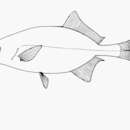Diagnostic Description
provided by Fishbase
Diagnosis: Dorsal fin up to 1.5 times in length of anal fin; origin of dorsal fin in advance of anal fin (Ref. 52193). Snout rounded, in front of mouth; eye well above mouth; chin with fleshy bulge (Ref. 4967). For distinguishing between specimens of Cyphomyrus discorhynchus en C. cubangoensis, the most useful anatomical characters are: longer dorsal fin length, longer anal fin length, higher number of dorsal fin rays and anal fin rays, and a higher caudal peduncle depth and caudal peduncle length ratio in C. discorhynchus than in C. cubangoensis (Ref. 119538).Description: Body relatively deep, compressed (Ref. 52193). Head rounded with blunt snout, mouth with mental lobe, teeth biscuspid, 5-6 in each jaw (Ref. 52193). Teeth in upper jaw 4-7; teeth in lower jaw 5-8 (Ref. 122874). Dorsal fin longer than anal, dorsal fin origin before anal fin origin, caudal fin forked, with round lobes; dorsal-fin rays 28-37; anal-fin rays 23-27; pectoral-fin rays 10-11; pelvic-fin rays 6 (Ref. 52193, 122874). Scales on lateral line 57-73; circumpeduncular scales 12-13; scales between dorsal and anal fins 28-31; scales between dorsal fin and lateral line 15-17; scales between pelvic fin and lateral line 14-17 (Ref. 52193, 122874). Total number of vertebrae 39-41 (Ref. 122874).Colouration: Greyish brown to dark brown, nearly black, lighter below, dark vertical bar sometimes evident between dorsal and anal fins (Ref. 52193).
Morphology
provided by Fishbase
Dorsal spines (total): 0; Dorsal soft rays (total): 28 - 37; Analspines: 0; Analsoft rays: 23 - 27; Vertebrae: 39 - 41
Trophic Strategy
provided by Fishbase
Nocturnal shoaling species; favors large river channels with a soft bottom and fringing vegetation (Ref. 7248). Found mainly in sheltered bays, lagoons and swampy areas. Occurs also in typical sandy/rocky rivers (Ref. 13337). Frequency of occurence in Caprivi: frequently on rocky streams, occasionally in standing deep water (Ref. 037065). Feeds on insect larvae at night. Known to migrate up tributary rivers of Lake Kariba during rainy season,though it is not yet clear whether this is a breeding migration (Ref. 13337). Breeds during the rainy season; females carry up to 5,000 eggs.
- Recorder
- Drina Sta. Iglesia
Biology
provided by Fishbase
Nocturnal shoaling species; favors large river channels with a soft bottom and fringing vegetation (Ref. 7248, 52193). Found mainly in sheltered bays, lagoons and swampy areas; occurs also in typical sandy or rocky rivers (Ref. 13337). Feeds on bottom-living invertebrates (Ref. 52193) and insect larvae at night (Ref. 5595). Known to migrate up tributary rivers of Lake Kariba during rainy season, though it is not yet clear whether this is a breeding migration (Ref. 13337). Breeds during summer rainy season; females carry up to 5,000 eggs (Ref. 7248).
Importance
provided by Fishbase
fisheries: minor commercial; aquarium: commercial
Zambezi parrotfish: Brief Summary
provided by wikipedia EN
The Zambezi parrotfish (Cyphomyrus discorhynchus) is an elephantfish in the family Mormyridae. It occurs in several river and lake systems across Central Africa and the northern half of Southern Africa. It grows to a length of 31 cm (12 in).
- license
- cc-by-sa-3.0
- copyright
- Wikipedia authors and editors

